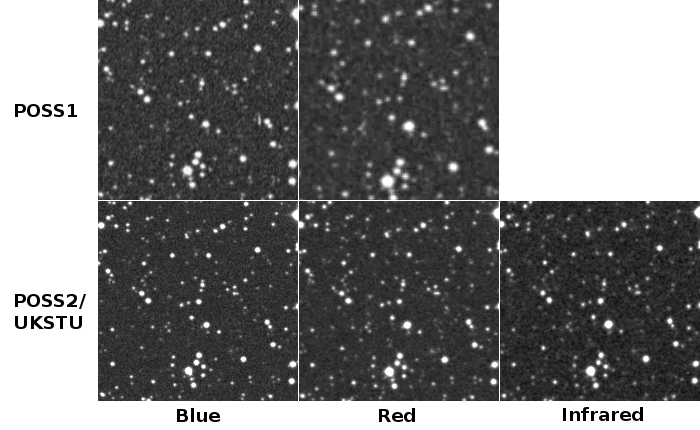Japanese version Home Page Updated on November 22, 2011
Details of New Mira Type Variable MisV1444's DiscoveryNovember 22, 2011Yoshida, S.; Nakashima, Y.; Arai, A.; Sato, H.; Suzuki, M.; Akawaza, H.; Fidrich, R. On April 9, 2011, Seiichi Yoshida, MISAO Project, discovered a new variable star MisV1444 from the survey images at Oku Observatory operated by Youichirou Nakashima, Setouchi, Okayama, Japan, taken on April 5. 
MisV1444 was bright as 13.1 mag on April 5, 2011. However, it was fainter than 15 mag on any older survey images of the MISAO Project on 7 days from 2001 to 2008. On the Digitized Sky Survey 2 (POSS2/UKSTU) images, it is not so bright on infrared plate. It looks brighter on the blue plate than infrared plate. Therefore, it does not seem to be an ordinary red variable.
 Digitized Sky Survey plates
The magnitude of MisV1444 measured from the Digitized Sky Survey images are as follows.
Robert Fidrich reported that ASAS-3 also has some positive observations of MisV1444. It was recorded bright as 11 mag only once, but faint around 14-16 mag all other time. 2450000+ 2758.86401 11.008 11.309 11.433 11.485 11.493 2909.50623 14.924 15.071 15.184 15.163 14.908 3116.87994 14.363 14.290 14.355 14.592 14.676 3127.86483 14.071 14.290 14.380 14.553 14.457 3146.78067 14.433 14.426 14.653 15.184 15.972 3576.57509 14.435 14.463 14.475 14.533 14.466 3585.54490 14.534 14.517 14.624 14.772 14.917 4966.79779 14.013 14.268 14.587 15.146 16.349 Hidetaka Sato and Masayuki Suzuki obtained multi band photometry, and MisV1444 was revealed to be red.
Hidehiko Akazawa obtained time series photometry on April 9 and 10, but no variation in a short time was detected.  Time series photometry by Hidehiko Akazawa (April 9)  Time series photometry by Hidehiko Akazawa (April 10) Akira Arai, Kyoto Sangyo Univ., obtained optical spectra of MisV1444 on April 10 using 1.3m Araki-telescope at Koyama Astronomical Observatory. Spectra of the object show TiO band features clearly on a red continuum light. The results suggest that MisV1444 might be a Mira variable star. Spectra of MisV1444 by Akira Arai The data of the Digitized Sky Survey does not seem to suggest an ordinary Mira type variable. Probably, that is because the POSS2 Blue plate was taken around the maximum, and the POSS2 Infrared plate was taken around the minimum. |
